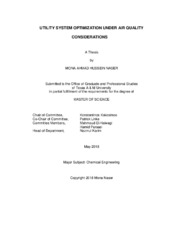| dc.description.abstract | Air pollution is a primary concern, and one of its major contributors is industry. Optimization of emissions from industrial facilities is well established in publications and reports. However, it does not extend beyond the stack or exhaust level i.e., emissions released to the atmosphere.
This work aspires to develop and test a methodology to optimize the operational scheme of a utility system considering air quality in the area around the facility by combining Process Design with Air Dispersion Modelling. The concept of this work is to investigate if atmospheric dispersion modeling can be used to improve pollution prevention/control by observing ground level concentration in the surrounding area of the unit at various operating scenarios and in different weather conditions. The methodology has been implemented in MATLAB following the coupling of a simple Gaussian dispersion model with a process model, both supplied with real meteorological and process data.
The case study used to test the methodology is a High Pressure Steam (HPS) generation unit. It consists of three identical boilers where the operational strategy is to operate two boilers, and the third is stand-by. The boilers accept two types of fuels: gas and liquid. Two separate optimization goals were studied. The first is to improve air quality in the surrounding area, i.e., minimize the ground level concentration, by changing the operating scheme of the three boilers. The second optimization goal is to reduce the operating costs by optimizing the ratio of the two fuels while keeping the resulting ground level concentration just below the regulations limit.
Finally, the methodology allowed to derive and assess the different operational strategies. The first goal improved the overall air quality and reached up to 46% reduction of the maximum concentration exceedances. The second goal proved that facilities can reduce operational costs and still be in compliance with environmental regulations. On the other hand, this cost reduction does lead to a decrease of overall air quality, since the average ground level concentration is increased. In the future, this methodology could be applied to more case studies and at the industrial city level to improve air quality and to assist on more appropriate environmental policies. | en |


